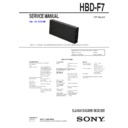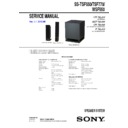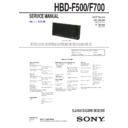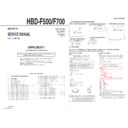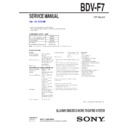Sony BDV-F7 / HBD-F7 Service Manual ▷ View online
SERVICE MANUAL
Sony Corporation
Published by Sony Techno Create Corporation
HBD-F7
SPECIFICATIONS
BLU-RAY DISC/DVD RECEIVER
9-889-927-01
2010H05-1
©
2010.08
US Model
Ver. 1.0 2010.08
Model Name Using Similar Mechanism
NEW
Mechanism Type
BSX-1
Optical Pick-up Name
KEM-460AAA
• HBD-F7 is the amplifi er, video, BD/DVD/Super Audio CD/CD system, USB, LAN and tuner section in BDV-F7.
Amplifier Section
POWER OUTPUT AND TOTAL HARMONIC
DISTORTION:
(FTC)
Front L + Front R:
DISTORTION:
(FTC)
Front L + Front R:
With 4 ohms loads, both
channels driven, from 200
- 20,000 Hz; rated 40 watts
per channel minimum
RMS power, with no more
than 1% total harmonic
distortion from 250 milli
watts to rated output.
channels driven, from 200
- 20,000 Hz; rated 40 watts
per channel minimum
RMS power, with no more
than 1% total harmonic
distortion from 250 milli
watts to rated output.
POWER OUTPUT (reference)
Front L/Front R:
Front L/Front R:
115 W (per channel at 4
ohms, 1 kHz)
ohms, 1 kHz)
Subwoofer:
120 W (at 4 ohms, 100 Hz)
Inputs (Analog)
AUDIO (IN)
AUDIO (IN)
Sensitivity: 450/250 mV
Inputs (Digital)
SAT/CABLE (DIGITAL IN OPTICAL),
TV (DIGITAL IN OPTICAL)
SAT/CABLE (DIGITAL IN OPTICAL),
TV (DIGITAL IN OPTICAL)
Supported formats: LPCM
2CH (up to 48 kHz), Dolby
Digital, DTS
2CH (up to 48 kHz), Dolby
Digital, DTS
Video Section
Outputs
VIDEO OUT: 1 Vp-p 75
ohms
HDMI OUT: Type A (19
pin)
ohms
HDMI OUT: Type A (19
pin)
BD/DVD/Super Audio CD/CD System
Signal format system
NTSC
USB Section
(USB) port:
Type A (For connecting
USB memory, memory
card reader, digital still
camera, and digital video
camera)
USB memory, memory
card reader, digital still
camera, and digital video
camera)
Maximum current:
500 mA
LAN Section
LAN (100) terminal
100BASE-TX Terminal
Tuner Section
System
PLL quartz-locked digital
synthesizer
synthesizer
FM tuner section
Tuning range
Tuning range
87.5 MHz - 108.0 MHz
(100 kHz step)
(100 kHz step)
Antenna (aerial)
FM wire antenna (aerial)
Antenna (aerial) terminals 75 ohms, unbalanced
Intermediate frequency
Intermediate frequency
10.7 MHz
General
Power requirements
120 V AC, 60 Hz
Power consumption
On: 90 W
Standby: 0.3 W (at the
Power Saving mode)
Standby: 0.3 W (at the
Power Saving mode)
Dimensions (approx.)
452 mm × 198 mm × 119
mm (17
mm (17
7
/
8
in × 7
7
/
8
in ×
4
3
/
4
in) (w/h/d) incl.
projecting parts
Mass (approx.)
5.0 kg (11 lb 1 oz)
Design and specifications are subject to change
without notice.
without notice.
HBD-F7
2
NOTES ON CHIP COMPONENT REPLACEMENT
•
•
Never reuse a disconnected chip component.
•
Notice that the minus side of a tantalum capacitor may be dam-
aged by heat.
aged by heat.
FLEXIBLE CIRCUIT BOARD REPAIRING
•
•
Keep the temperature of soldering iron around 270 °C during
repairing.
repairing.
•
Do not touch the soldering iron on the same conductor of the
circuit board (within 3 times).
circuit board (within 3 times).
•
Be careful not to apply force on the conductor when soldering
or unsoldering.
or unsoldering.
SAFETY-RELATED COMPONENT WARNING!
COMPONENTS IDENTIFIED BY MARK
0 OR DOTTED LINE
WITH MARK
0 ON THE SCHEMATIC DIAGRAMS AND IN
THE PARTS LIST ARE CRITICAL TO SAFE OPERATION.
REPLACE THESE COMPONENTS WITH SONY PARTS
REPLACE THESE COMPONENTS WITH SONY PARTS
WHOSE PART NUMBERS APPEAR AS SHOWN IN THIS
MANUAL OR IN SUPPLEMENTS PUBLISHED BY SONY.
MANUAL OR IN SUPPLEMENTS PUBLISHED BY SONY.
CAUTION
Use of controls or adjustments or performance of procedures
other than those specifi ed herein may result in hazardous radia-
tion exposure.
Use of controls or adjustments or performance of procedures
other than those specifi ed herein may result in hazardous radia-
tion exposure.
SAFETY CHECK-OUT
After correcting the original service problem, perform the follow-
ing safety check before releasing the set to the customer:
Check the antenna terminals, metal trim, “metallized” knobs,
screws, and all other exposed metal parts for AC leakage.
Check leakage as described below.
After correcting the original service problem, perform the follow-
ing safety check before releasing the set to the customer:
Check the antenna terminals, metal trim, “metallized” knobs,
screws, and all other exposed metal parts for AC leakage.
Check leakage as described below.
LEAKAGE TEST
The AC leakage from any exposed metal part to earth ground and
from all exposed metal parts to any exposed metal part having a
return to chassis, must not exceed 0.5 mA (500 microamperes.).
Leakage current can be measured by any one of three methods.
1. A commercial leakage tester, such as the Simpson 229 or RCA
The AC leakage from any exposed metal part to earth ground and
from all exposed metal parts to any exposed metal part having a
return to chassis, must not exceed 0.5 mA (500 microamperes.).
Leakage current can be measured by any one of three methods.
1. A commercial leakage tester, such as the Simpson 229 or RCA
WT-540A. Follow the manufacturers’ instructions to use these
instruments.
instruments.
2. A battery-operated AC milliammeter. The Data Precision 245
digital multimeter is suitable for this job.
3. Measuring the voltage drop across a resistor by means of a
VOM or battery-operated AC voltmeter. The “limit” indication
is 0.75 V, so analog meters must have an accurate low-voltage
scale. The Simpson 250 and Sanwa SH-63Trd are examples
of a passive VOM that is suitable. Nearly all battery operated
digital multimeters that have a 2 V AC range are suitable. (See
Fig. A)
is 0.75 V, so analog meters must have an accurate low-voltage
scale. The Simpson 250 and Sanwa SH-63Trd are examples
of a passive VOM that is suitable. Nearly all battery operated
digital multimeters that have a 2 V AC range are suitable. (See
Fig. A)
1.5 k
Ω
0.15
μF
AC
voltmeter
(0.75 V)
voltmeter
(0.75 V)
To Exposed Metal
Parts on Set
Parts on Set
Earth Ground
Fig. A. Using an AC voltmeter to check AC leakage.
This appliance is classified as a
CLASS 3R LASER product.
Visible and invisible laser radiation
is emitted when the laser protective
housing is opened, so be sure to
avoid direct eye exposure.
CLASS 3R LASER product.
Visible and invisible laser radiation
is emitted when the laser protective
housing is opened, so be sure to
avoid direct eye exposure.
This marking is located on the laser
protective housing inside the
enclosure.
protective housing inside the
enclosure.
This appliance is classified as a
CLASS 1 LASER product. The
CLASS 1 LASER PRODUCT
MARKING is located on the laser
protective housing inside the
enclosure.
CLASS 1 LASER product. The
CLASS 1 LASER PRODUCT
MARKING is located on the laser
protective housing inside the
enclosure.
s This system incorporates with
Dolby* Digital and the DTS**
Digital Surround System.
Digital Surround System.
* Manufactured under license
from Dolby Laboratories.
Dolby and the double-D
symbol are trademarks of
Dolby Laboratories.
Dolby and the double-D
symbol are trademarks of
Dolby Laboratories.
** Manufactured under license
under U.S. Patent #’s:
5,451,942; 5,956,674;
5,974,380; 5,978,762;
6,226,616; 6,487,535;
7,212,872; 7,333,929;
7,392,195; 7,272,567 &
other U.S. and worldwide
patents issued & pending.
DTS and the Symbol are
registered trademarks, &
DTS-HD, DTS-HD Master
Audio, and the DTS logos
are trademarks of DTS, Inc.
Product includes software.
© DTS, Inc. All Rights
Reserved.
5,451,942; 5,956,674;
5,974,380; 5,978,762;
6,226,616; 6,487,535;
7,212,872; 7,333,929;
7,392,195; 7,272,567 &
other U.S. and worldwide
patents issued & pending.
DTS and the Symbol are
registered trademarks, &
DTS-HD, DTS-HD Master
Audio, and the DTS logos
are trademarks of DTS, Inc.
Product includes software.
© DTS, Inc. All Rights
Reserved.
s “AVCHD” and the “AVCHD”
logo are trademarks of Matsushita
Electric Industrial Co., Ltd. and
Sony Corporation.
Electric Industrial Co., Ltd. and
Sony Corporation.
s Java and all Java-based
trademarks and logos are
trademarks or registered
trademarks of Sun Microsystems,
Inc.
trademarks or registered
trademarks of Sun Microsystems,
Inc.
s
, “XMB,” and “xross media
bar” are trademarks of Sony
Corporation and Sony Computer
Entertainment Inc.
Corporation and Sony Computer
Entertainment Inc.
s This system incorporates High-
Definition Multimedia Interface
(HDMI
(HDMI
TM
) technology.
HDMI, the HDMI logo and High-
Definition Multimedia Interface
are trademarks or registered
trademarks of HDMI Licensing
LLC.
Definition Multimedia Interface
are trademarks or registered
trademarks of HDMI Licensing
LLC.
s “Blu-ray Disc” is a trademark.
s “Blu-ray Disc,” “DVD+RW,”
s “Blu-ray Disc,” “DVD+RW,”
“DVD-RW,” “DVD+R,” “DVD-
R,” “DVD VIDEO,” and “CD”
logos are trademarks.
R,” “DVD VIDEO,” and “CD”
logos are trademarks.
s “BD-LIVE” and
“BONUSVIEW” are trademarks
of Blu-ray Disc Association.
of Blu-ray Disc Association.
s “Blu-ray 3D” and “Blu-ray 3D”
logo are trademarks of Blu-ray
Disc Association.
Disc Association.
s “BRAVIA” is a trademark of
Sony Corporation.
s “PhotoTV HD” and the “PhotoTV
HD” logo are trademarks of Sony
Corporation.
Corporation.
s MPEG Layer-3 audio coding
technology and patents licensed
from Fraunhofer IIS and
Thomson.
from Fraunhofer IIS and
Thomson.
s Music and video recognition
technology and related data are
provided by Gracenote
provided by Gracenote
®
.
Gracenote is the industry standard
in music recognition technology
and related content delivery. For
more information, please visit
www.gracenote.com.
CD, DVD, Blu-ray Disc, and
music and video-related data from
Gracenote, Inc., copyright ©
2000-present Gracenote.
Gracenote Software, copyright ©
2000-present Gracenote. One or
more patents owned by Gracenote
apply to this product and service.
See the Gracenote website for a
nonexhaustive list of applicable
Gracenote patents. Gracenote,
CDDB, MusicID, MediaVOCS,
the Gracenote logo and logotype,
and the “Powered by Gracenote”
logo are either registered
trademarks or trademarks of
Gracenote in the United States
and/or other countries.
in music recognition technology
and related content delivery. For
more information, please visit
www.gracenote.com.
CD, DVD, Blu-ray Disc, and
music and video-related data from
Gracenote, Inc., copyright ©
2000-present Gracenote.
Gracenote Software, copyright ©
2000-present Gracenote. One or
more patents owned by Gracenote
apply to this product and service.
See the Gracenote website for a
nonexhaustive list of applicable
Gracenote patents. Gracenote,
CDDB, MusicID, MediaVOCS,
the Gracenote logo and logotype,
and the “Powered by Gracenote”
logo are either registered
trademarks or trademarks of
Gracenote in the United States
and/or other countries.
s Windows Media is either a
registered trademark or trademark
of Microsoft Corporation in the
United States and/or other
countries.
of Microsoft Corporation in the
United States and/or other
countries.
s DLNA
®
, the DLNA Logo and
DLNA CERTIFIED™ are
trademarks, service marks, or
certification marks of the Digital
Living Network Alliance.
trademarks, service marks, or
certification marks of the Digital
Living Network Alliance.
s iPod is a trademark of Apple Inc.,
registered in the U.S. and other
countries.
countries.
s “Made for iPod” means that an
electronic accessory has been
designed to connect specifically
to iPod and has been certified by
the developer to meet Apple
performance standards.
designed to connect specifically
to iPod and has been certified by
the developer to meet Apple
performance standards.
s Apple is not responsible for the
operation of this device or its
compliance with safety and
regulatory standards.
compliance with safety and
regulatory standards.
s “PLAYSTATION” is a trademark
of Sony Computer Entertainment
Inc.
Inc.
s Other system and product names
are generally trademarks or
registered trademarks of the
manufacturers. ™ and ® marks
are not indicated in this document.
registered trademarks of the
manufacturers. ™ and ® marks
are not indicated in this document.
HBD-F7
3
1.
SERVICING NOTES
............................................. 4
2. DISASSEMBLY
2-1. Disassembly
Flow
........................................................... 12
2-2. Rear Cover Block ............................................................ 13
2-3. Bottom
2-3. Bottom
(COM)
Assy
....................................................... 13
2-4. Front Panel Block ........................................................... 14
2-5. Hamon (COM) Block ..................................................... 15
2-6. Shield Plate (Rear) Block ............................................... 15
2-7. Shield Plate (Front) Block, Fuse (F901) ......................... 16
2-8. AMP
2-5. Hamon (COM) Block ..................................................... 15
2-6. Shield Plate (Rear) Block ............................................... 15
2-7. Shield Plate (Front) Block, Fuse (F901) ......................... 16
2-8. AMP
Board
..................................................................... 16
2-9. POWER
Board
................................................................ 17
2-10. Tuner Block..................................................................... 18
2-11. AUDIO Board ................................................................. 18
2-12. Shield Plate (Audio) Block ............................................. 19
2-13. USB Board Block ........................................................... 19
2-14. MB-134 Board ................................................................ 20
2-15. BD Drive Block (BSX-1) ............................................... 20
2-16. Bottom Cover .................................................................. 21
2-17. Optical Device (KEM-460AAA) .................................... 22
2-18. How To Bend FFC .......................................................... 22
2-11. AUDIO Board ................................................................. 18
2-12. Shield Plate (Audio) Block ............................................. 19
2-13. USB Board Block ........................................................... 19
2-14. MB-134 Board ................................................................ 20
2-15. BD Drive Block (BSX-1) ............................................... 20
2-16. Bottom Cover .................................................................. 21
2-17. Optical Device (KEM-460AAA) .................................... 22
2-18. How To Bend FFC .......................................................... 22
3.
TEST MODE
............................................................ 24
4.
ELECTRICAL CHECK
......................................... 33
5. DIAGRAMS
5-1. Block Diagram - SERVO Section - ................................ 35
5-2. Block Diagram - MEMORY Section - ............................ 36
5-3. Block Diagram - AUDIO Section - ................................. 37
5-4. Block Diagram - AMP Section - ..................................... 38
5-5. Block Diagram - REGULATOR Section - ...................... 39
5-6. Block
5-2. Block Diagram - MEMORY Section - ............................ 36
5-3. Block Diagram - AUDIO Section - ................................. 37
5-4. Block Diagram - AMP Section - ..................................... 38
5-5. Block Diagram - REGULATOR Section - ...................... 39
5-6. Block
Diagram
- PANEL, POWER SUPPLY Section - ........................... 40
5-7. Printed
Wiring
Board
- MB-134 Board (Component Side) - ............................. 42
5-8. Printed
Wiring
Board
- MB-134 Board (Conductor Side) - ............................... 43
5-9. Schematic Diagram - MB-134 Board (1/13) - ................ 44
TABLE OF CONTENTS
5-10. Schematic Diagram - MB-134 Board (2/13) - ................ 45
5-11. Schematic Diagram - MB-134 Board (3/13) - ................ 46
5-12. Schematic Diagram - MB-134 Board (4/13) - ................ 47
5-13. Schematic Diagram - MB-134 Board (5/13) - ................ 48
5-14. Schematic Diagram - MB-134 Board (6/13) - ................ 49
5-15. Schematic Diagram - MB-134 Board (7/13) - ................ 50
5-16. Schematic Diagram - MB-134 Board (8/13) - ................ 51
5-17. Schematic Diagram - MB-134 Board (9/13) - ................ 52
5-18. Schematic Diagram - MB-134 Board (10/13) - .............. 53
5-19. Schematic Diagram - MB-134 Board (11/13) - .............. 54
5-20. Schematic Diagram - MB-134 Board (12/13) - .............. 55
5-21. Schematic Diagram - MB-134 Board (13/13) - .............. 56
5-22. Printed Wiring Board - AUDIO Board - ......................... 57
5-23. Schematic Diagram - AUDIO Board (1/2) - ................... 58
5-24. Schematic Diagram - AUDIO Board (2/2) - ................... 59
5-25. Printed Wiring Board
5-11. Schematic Diagram - MB-134 Board (3/13) - ................ 46
5-12. Schematic Diagram - MB-134 Board (4/13) - ................ 47
5-13. Schematic Diagram - MB-134 Board (5/13) - ................ 48
5-14. Schematic Diagram - MB-134 Board (6/13) - ................ 49
5-15. Schematic Diagram - MB-134 Board (7/13) - ................ 50
5-16. Schematic Diagram - MB-134 Board (8/13) - ................ 51
5-17. Schematic Diagram - MB-134 Board (9/13) - ................ 52
5-18. Schematic Diagram - MB-134 Board (10/13) - .............. 53
5-19. Schematic Diagram - MB-134 Board (11/13) - .............. 54
5-20. Schematic Diagram - MB-134 Board (12/13) - .............. 55
5-21. Schematic Diagram - MB-134 Board (13/13) - .............. 56
5-22. Printed Wiring Board - AUDIO Board - ......................... 57
5-23. Schematic Diagram - AUDIO Board (1/2) - ................... 58
5-24. Schematic Diagram - AUDIO Board (2/2) - ................... 59
5-25. Printed Wiring Board
- AMP Board (Component Side) - .................................. 60
5-26. Printed Wiring Board
- AMP Board (Conductor Side) - .................................... 61
5-27. Schematic Diagram - AMP Board (1/4) - ....................... 62
5-28. Schematic Diagram - AMP Board (2/4) - ....................... 63
5-29. Schematic Diagram - AMP Board (3/4) - ....................... 64
5-30. Schematic Diagram - AMP Board (4/4) - ....................... 65
5-31. Printed Wiring Board - FL Board - ................................. 66
5-32. Schematic Diagram - FL Board - .................................... 67
5-33. Printed Wiring Boards - PANEL Section - ..................... 68
5-34. Schematic Diagram - PANEL Section - .......................... 69
5-35. Printed Wiring Board - POWER Board - ........................ 70
5-36. Schematic Diagram - POWER Board - .......................... 71
5-28. Schematic Diagram - AMP Board (2/4) - ....................... 63
5-29. Schematic Diagram - AMP Board (3/4) - ....................... 64
5-30. Schematic Diagram - AMP Board (4/4) - ....................... 65
5-31. Printed Wiring Board - FL Board - ................................. 66
5-32. Schematic Diagram - FL Board - .................................... 67
5-33. Printed Wiring Boards - PANEL Section - ..................... 68
5-34. Schematic Diagram - PANEL Section - .......................... 69
5-35. Printed Wiring Board - POWER Board - ........................ 70
5-36. Schematic Diagram - POWER Board - .......................... 71
6.
EXPLODED VIEWS
6-1. Rear Cover Section ......................................................... 96
6-2. Front Panel Section ......................................................... 97
6-3. AMP Board Section ........................................................ 98
6-4. MB-134 Board Section ................................................... 99
6-5. Front Shield Section ........................................................ 100
6-6. POWER Board Section ................................................... 101
6-7. BD Drive Section (BSX-1) ............................................. 102
6-2. Front Panel Section ......................................................... 97
6-3. AMP Board Section ........................................................ 98
6-4. MB-134 Board Section ................................................... 99
6-5. Front Shield Section ........................................................ 100
6-6. POWER Board Section ................................................... 101
6-7. BD Drive Section (BSX-1) ............................................. 102
7.
ELECTRICAL PARTS LIST
.............................. 103
HBD-F7
4
SECTION 1
SERVICING NOTES
NOTES ON HANDLING THE OPTICAL PICK-UP
BLOCK OR BASE UNIT
BLOCK OR BASE UNIT
The laser diode in the optical pick-up block may suffer electro-
static break-down because of the potential difference generated by
the charged electrostatic load, etc. on clothing and the human body.
During repair, pay attention to electrostatic break-down and also
use the procedure in the printed matter which is included in the
repair parts.
The fl exible board is easily damaged and should be handled with
care.
static break-down because of the potential difference generated by
the charged electrostatic load, etc. on clothing and the human body.
During repair, pay attention to electrostatic break-down and also
use the procedure in the printed matter which is included in the
repair parts.
The fl exible board is easily damaged and should be handled with
care.
NOTES ON LASER DIODE EMISSION CHECK
The laser beam on this model is concentrated so as to be focused
on the disc refl ective surface by the objective lens in the optical
pickup block. Therefore, when checking the laser diode emission,
observe from more than 30 cm away from the objective lens.
The laser beam on this model is concentrated so as to be focused
on the disc refl ective surface by the objective lens in the optical
pickup block. Therefore, when checking the laser diode emission,
observe from more than 30 cm away from the objective lens.
UNLEADED SOLDER
Boards requiring use of unleaded solder are printed with the lead-
free mark (LF) indicating the solder contains no lead.
(Caution: Some printed circuit boards may not come printed with
Boards requiring use of unleaded solder are printed with the lead-
free mark (LF) indicating the solder contains no lead.
(Caution: Some printed circuit boards may not come printed with
the lead free mark due to their particular size)
: LEAD FREE MARK
Unleaded solder has the following characteristics.
• Unleaded solder melts at a temperature about 40 °C higher
• Unleaded solder melts at a temperature about 40 °C higher
than ordinary solder.
Ordinary soldering irons can be used but the iron tip has to be
applied to the solder joint for a slightly longer time.
applied to the solder joint for a slightly longer time.
Soldering irons using a temperature regulator should be set to
about 350 °C.
Caution: The printed pattern (copper foil) may peel away if
about 350 °C.
Caution: The printed pattern (copper foil) may peel away if
the heated tip is applied for too long, so be careful!
• Strong
viscosity
Unleaded solder is more viscous (sticky, less prone to fl ow)
than ordinary solder so use caution not to let solder bridges
occur such as on IC pins, etc.
than ordinary solder so use caution not to let solder bridges
occur such as on IC pins, etc.
• Usable with ordinary solder
It is best to use only unleaded solder but unleaded solder may
also be added to ordinary solder.
also be added to ordinary solder.
Part No.
Description
Layer
J-6090-199-A
BLX-104
Single Layer
J-6090-200-A
BLX-204
Dual Layer
J-2501-307-A
CD (HLX-A1)
J-2501-305-A
HLX-513
Single Layer (NTSC)
J-2501-306-A
HLX-514
Dual Layer (NTSC)
J-6090-077-A
HLX-506
Single Layer (PAL)
J-6090-078-A
HLX-507
Dual Layer (PAL)
TEST DISC
Note: Refer to the service manual of BDP-BX1/S350 (Part No. 9-883-
989-1
[]) (page 1-3 to 1-14E) for the use of BLX-104/204.
Operation and Display:
1. BLX-104
Procedure:
1. Select
Procedure:
1. Select
23.976Hz/1080p.
2. Play “4.Motion picture”.
3. Check whether player can play back or not.
4. Check each outputs.
Video:
Composite/S
3. Check whether player can play back or not.
4. Check each outputs.
Video:
Composite/S
Video/component/HDMI.
Audio:
Speaker
Speaker
out.
* When 1080/24p monitor is nothing, 1080i (59.94Hz or 50Hz)
can use instead of 1080/24p.
However this is temporary correspondence.
2. BLX-204
Procedure:
1. Select 1080i (59.94Hz or 50Hz).
2. Play “4.Motion picture”.
3. Check whether player can play back or not (Check the picture
Procedure:
1. Select 1080i (59.94Hz or 50Hz).
2. Play “4.Motion picture”.
3. Check whether player can play back or not (Check the picture
and sound output).
3. CD (HLX-A1)
Procedure:
Check whether player can play back or not (Check the sound out-
put).
Procedure:
Check whether player can play back or not (Check the sound out-
put).
4. HLX-513/514 (NTSC), HLX-506/507 (PAL)
Procedure:
1. After displayed Main Menu, select “1.Video Signal”.
2. Play “1.Color bar 100%” (Check the picture and sound out-
Procedure:
1. After displayed Main Menu, select “1.Video Signal”.
2. Play “1.Color bar 100%” (Check the picture and sound out-
put).
3. Return to Menu.
4. Play “Demonstration 4:3” or “Demonstration 16:9” (Check the
4. Play “Demonstration 4:3” or “Demonstration 16:9” (Check the
picture and sound output).
NOTE THE IC101, IC104, IC105, IC204, IC205, IC307,
IC311, IC501 AND IC502 ON THE MB-134 BOARD
REPLACING
IC101, IC104, IC105, IC204, IC205, IC307, IC311, IC501 and
IC502 on the MB-134 board cannot exchange with single. When
these parts are damaged, exchange the entire mounted board.
IC311, IC501 AND IC502 ON THE MB-134 BOARD
REPLACING
IC101, IC104, IC105, IC204, IC205, IC307, IC311, IC501 and
IC502 on the MB-134 board cannot exchange with single. When
these parts are damaged, exchange the entire mounted board.
RELEASING THE DISC SLOT LOCK
The disc slot lock function for the antitheft of an demonstration
disc in the store is equipped.
The disc slot lock function for the antitheft of an demonstration
disc in the store is equipped.
Releasing Procedure:
1. Press the [
1. Press the [
?/1
] button to turn on the system.
2. Press the [FUNCTION] button to select “BD/DVD”.
3. Press the [
3. Press the [
x
] and [
Z
] buttons simultaneously and hold for
more than fi ve seconds, the message “DEMO OFF” is dis-
played on the fluorescent indicator tube.
played on the fluorescent indicator tube.
Note: When “DEMO ON” is displayed, the disc slot lock is not released
by turning power on/off with the [
?/1] button.
ABOUT THE LENS CLEANING
Do not do the lens cleaning with the cotton bud etc. It causes the
trouble.
Do not do the lens cleaning with the cotton bud etc. It causes the
trouble.

